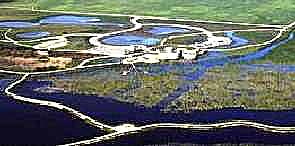Oak Hammock Marsh
Our final site was Oak Hammock Marsh. Of all the places we had intended to visit on this trip to Canada this was my number one target.The marsh is situated 32 km north of Winnipeg and just east of Stonewall. It is an important wildlife site in this area and was designated a Ramsar site in 1987.
The journey from Fort Whyte to Oak Hammock took us north up Highway 7 and east along Highway 220. Oak Hammock Marsh is sign posted along the 220.
This is across genuine prairie, a habitat many non-birders seem to think will be birdless. We proved them wrong. We saw
Northern Shoveler, Blue-winged Teal, Yellow-headed and Red-winged Blackbirds, Killdeer, Bobolink and Western Kingbird. The last of these only I saw so Joanne kindly turned the car around and went back to have a look. This was extremely fortuitous because when we stopped the car opposite where I saw the kingbird we had an Upland Sandpiper down to about four metres in front of us, walking towards the car. It did cause us some concern as it crossed the highway but it made it safely and continued to feed on the central reservation.
As we approached Oak Hammock we spotted a raptor sitting in a field. This turned out to be a male Northern Harrier and showed well both on the ground and in flight.
Then we were entering the carpark of Oak Hammock Marsh. A small pool by the side of the carpark held a Short-billed Dowitcher, Lesser Scaup and numerous Killdeers. When we stopped we saw a Purple Martin house inhabited by Purple Martins, Common and Forster's Terns flying overhead, two Western Kingbirds in a tree, a Black-crowned Night-heron flying away and, best of all, a first-summer male Orchard Oriole sitting on top of a tree and easily seen.

Oak Hammock Marsh
Heading into the marsh we followed the path to the left to where a ranger said the best waders were. Along this path were, again, numerous Killdeers. The first open water held American Coot, Pied-billed Grebe (heard only since they hid in the reeds), Yellow-headed and Red-winged Blackbirds, Redhead, Gadwall and Canvasback. On the other side of the path was an area of much shallower water and open mud. Here things got even better. The bird I most wanted to see this trip and which I thought I had no real hope of seeing was American Avocet - we saw three! Also here were two Willets, a Lesser Yellowlegs, a Marbled Godwit, a Black-bellied (Grey) Plover, and a male Green-winged Teal. Everywhere we saw Black Terns looking considerably darker than any we have seen in Britain.
We walked back down the path and towards the largest area of open water. Here there is a channel containing a small stream, a reed bed, then some islands, then the open water. A scan of the islands yielded three American White Pelicans with a Double-crested Cormorant, and three Snow Geese (one blue phase) left over from the main winter flocks. A bird flew up from the reeds in front of us and Joanne shouted 'It's a Bittern' and we watched American Bittern as it flew sedately over the reeds and then disappeared into them. Scanning the open water we saw at least six Eared (Black-necked) Grebes, and more Canvasbacks and Lesser Scaups.
Back near the carpark we added Common Yellowthroat, Marsh Wren, Great Blue Heron, Common Raven and two female Northern Harriers quartering the reeds.
That was our last serious day's birding for the holiday. We did add Peregrine in the city the next day and saw three Red-tailed Hawks, American Kestrel, Western Meadowlark, Common Grackle, Killdeer, Tree Swallow, Red-winged Blackbird and Franklin's Gull at the airport on June 14th.
We would both like to thank Joanne Tuckwell for taking time off work to guide us around these sites. Without her, and indeed without a car, neither Fort Whyte nor Oak Hammock would have been visited.

